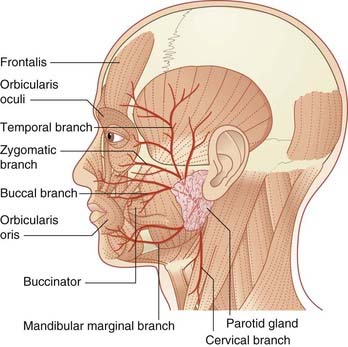22 Facial nerve
Facial Nerve
The facial nerve arises from the branchial (special visceral) efferent cell column caudal to the motor nucleus of the trigeminal nerve (Figure 17.2). The facial nucleus occupies the lateral region of the tegmentum in the caudal part of the pons (Figures 17.15, 22.1). Before emerging from the brainstem, it loops, as the internal genu, around the abducens nucleus, creating the facial colliculus in the floor of the fourth ventricle.

Figure 22.1 Transverse section of the pons, showing the facial nerve and the nervus intermedius (NI).
The nerve emerges at the lower border of the pons together with the nervus intermedius. Both nerves cross the subarachnoid space in company with the vestibulocochlear nerve, to the internal acoustic meatus. Above the vestibule of the labyrinth, it enters a 7-shaped bony canal having a backward bend at the external genu of the facial nerve. Prior to escaping the canal at the stylomastoid foramen, it supplies the stapedius muscle. Upon escape, it supplies the posterior belly of the occipitofrontalis, the stylohyoid, and the posterior belly of the digastric. It then turns forward within the substance of the parotid gland while breaking up into the five named branches to the muscles of facial expression (Figure 22.2).
Supranuclear connections
All of the cells of the motor nucleus receive a corticonuclear supply from the ‘face’ area of the contralateral motor cortex. In addition, those to the muscles of the upper face (occi-pitofrontalis and orbicularis oculi) receive an equal supply from the ipsilateral motor cortex. The bilateral supply for the upper facial muscles is reflected in their habitual paired activities in wrinkling the forehead, blinking, and squeezing the eyes closed. The muscles around the mouth, on the other hand, are often activated unilaterally for some expressive purpose. The partial bilateral supply to the facial muscles helps to distinguish a supranuclear from a nuclear or infranuclear lesion of the nerve (Clinical Panel 22.1).
Clinical Panel 22.1 Lesions of the facial nerve
Nuclear lesions
The main motor nucleus may be involved in thrombosis of one of the pontine branches of the basilar artery. As might be anticipated from the relationships depicted in Figure 22.1, the usual result of such a lesion is an alternating (crossed) hemiplegia: complete paralysis of the facial and/or abducens nerve on one side combined with motor weakness of the limbs on the opposite side owing to concomitant involvement of the corticospinal tract.










